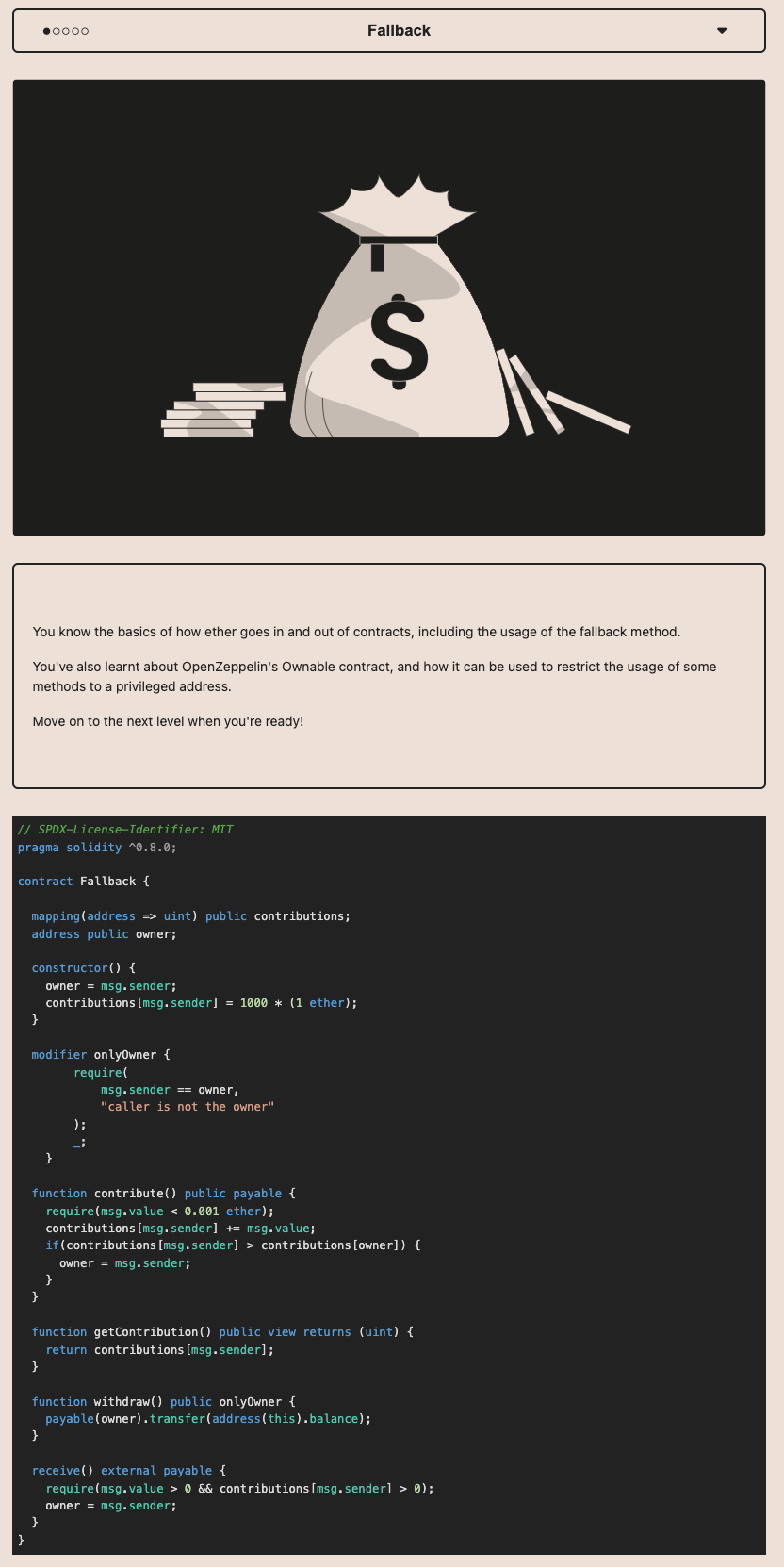This Web3/Solidity-based wargame is akin to a hacking Capture The Flag (CTF) challenge, where each level presents a smart contract puzzle waiting to be ‘hacked’. It’s an immersive and interactive way to learn about Ethereum and Solidity programming.

Unraveling the First Puzzle:
What is a Fallback function:
It is best practice to implement a simple Fallback function, if you want your smart contract to receiver Ether.
Anyone can call a fallback function by:
– Calling a function that doesn’t exist inside the contract, or
– Calling a function without passing in required data, or
– Sending Ether without any data to the contract
In the “Fallback” challenge of Ethernaut, I encountered a captivating introduction to the intricacies of fallback functions in Ethereum smart contracts. The objective here is to take control of the contract and drain its Ether balance.
Approach
To overcome this challenge, a strategic approach focused on exploiting the mechanics of the fallback function is essential.
• Analyze the Contract: Begin by comprehending how the fallback function operates, particularly the conditions governing its ownership transfer.
• Claim Ownership: Initiate an action that triggers the fallback function and satisfies its ownership transfer condition, thereby becoming the contract’s new owner.
• Withdraw Funds: Once in control, invoke the contract’s withdraw function to transfer its Ether balance to your account.
Implementation Using Remix IDE:
- Paste the contract code into the Remix IDE.
- Retrieve the Sepolia Deployed contract instance by loading the contract via the address recevied when generating a new instance from the Ethernaut challenge website.
- Send a small amount
require(msg.value < 0.001 ether);to this contract, using thecontributefunction within the contract in remix. Be sure to use same account address to send money to the contract as the one playing the Ethernaut challange. - Finally, add some arbitrary value into the
valuefield and trigger the(fallback)function by sending a transaction from your Remix IDE to the contract Address.
Inside the console of the Ethernaut challenge website, check that you now own the contract by typingawait contract.owner();
this should return your contract address if everything has been done successfully.
Lastly Submit your instance and Congrats.
Insights Gained
• Role and Risks of Fallback Functions: Gain a deeper understanding of the pivotal role played by fallback functions and the potential risks associated with them if not properly secured or understood.
• Conditional Ownership Transfer: Discover how ownership of a contract can be conditionally transferred, highlighting the importance of understanding contract conditions.
• Smart Contract Security: This challenge underscores the significance of rigorous smart contract testing and review to mitigate unintended behaviours and security vulnerabilities.
Looking Ahead in the Series
Checkout the next challenge, Ethernaut Level 2: Fallout

FAQ
Q1: What is the Ethernaut Challenge?
The Ethernaut Challenge is a Web3/Solidity-based wargame designed to teach Ethereum and Solidity programming through interactive hacking puzzles. Each level presents a smart contract challenge that requires understanding and exploiting specific vulnerabilities or features within the Ethereum ecosystem.
Q2: Why are fallback functions important in Ethereum smart contracts? Fallback functions are crucial because they allow Ethereum smart contracts to receive Ether and react to transactions that do not match any of the defined functions. They play a vital role in contract’s behavior when it’s called in a way that doesn’t correspond to any of its methods, ensuring flexibility and safety in handling transactions.
Q3: How can fallback functions be exploited?
Fallback functions can be exploited if they are not properly secured, especially in contracts that perform important actions or state changes without adequate conditions or validations. Attackers may manipulate these functions to take control over the contract or drain its funds if the fallback function allows unexpected interactions.
Q4: What is Remix IDE and how is it used in solving Ethernaut challenges? Remix IDE is an open-source web application for Ethereum development. It provides tools for writing, deploying, and testing smart contracts in Solidity. In solving Ethernaut challenges, Remix IDE is used to write and interact with smart contracts, allowing users to deploy code, call functions, and simulate interactions with the contracts as part of the puzzle-solving process
Q5: How can I ensure my smart contracts are secure from fallback function vulnerabilities?
To secure your smart contracts from fallback function vulnerabilities, ensure that fallback functions are simple and avoid making state changes unless absolutely necessary. Always validate the input and conditions under which they operate. Regularly auditing your contracts and adhering to best practices in smart contract development, such as those outlined in the Ethereum Smart Contract Best Practices guide, is also crucial.








